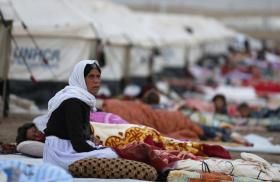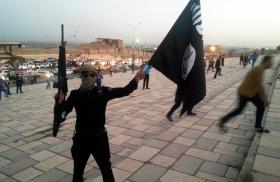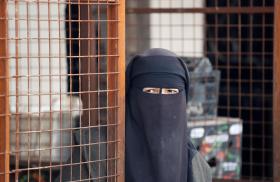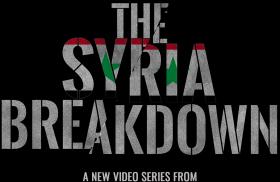
- Policy Analysis
- Counterterrorism Lecture
Confronting the Changing Face of al-Qaeda Propaganda

Part of a series: Counterterrorism Lecture Series
or see Part 1: U.S. Efforts against Terrorism Financing: A View from the Private Sector
The coordinator of the U.S. Center for Strategic Counterterrorism Communications describes how the "new normal" in global jihadist radicalization will require Washington and its allies to use public diplomacy as a major soft-power tool in countering violent extremism, both online and on the ground. Watch video or read his remarks.
The following are Ambassador Fernandez's prepared remarks, delivered as part of The Washington Institute's Counterterrorism Lecture Series.
It is a great pleasure for me to speak to you today as part of The Washington Institute's lecture series. I have followed and appreciated the work of The Washington Institute and its outstanding team of experts for years, ever since I was with Rob Satloff when his shoes were stolen at the Umayyad Mosque in Damascus almost twenty years ago. And as far as counterterrorism analysis is concerned, Matt Levitt and Aaron Zelin are essential reading.
It is a little over two years ago, on November 18, 2011, since my predecessor, Ambassador Richard LeBaron, spoke here shortly after the White House executive order formally creating the Center for Strategic Counterterrorism Communications (CSCC), and it is, perhaps, a good time for stock taking on where we are in the communications struggle, how al-Qaeda and friends are using media, and the very real challenges that remain.
Al-Qaeda has always valued the power of communications. It began its formal existence, in 1998, with a press release and a fatwa. In those early days, it sought to maximize the use of burgeoning Arabic-language broadcast media and even tried to have a media office in London. Those first attacks on the U.S. embassies in East Africa which imprinted themselves on our consciousness came months later. But before the deed, there was a story, a narrative to be told.
Over the years, al-Qaeda and its fellow travelers have transitioned to new platforms and mechanisms as circumstances have changed. As opportunities to use broadcast media became more constrained, they shifted to password-protected forums and in late 2012 the extremists' migration to social media such as Twitter and beyond accelerated. In the ceaseless search for an audience, they seek to spread their message in new languages, so we see al-Qaeda in the Islamic Maghreb (AQIM) producing material in French and Spanish and al-Qaeda in the Arabian Peninsula (AQAP) and the Islamic State of Iraq and al-Sham (ISIS) subtitling material in English.
Each al-Qaeda branch seeks to have a robust propaganda arm, although their effectiveness waxes and wanes according to circumstances. AQIM's media arm, al-Andalus, is probably the least effective and active of all. AQAP for a long time had probably the most active and sophisticated media operation -- they are the ones behind Inspire magazine -- but in my estimation, their recent material is far less polished and effective since the Yemeni army drove them out of some of their safe havens in 2012. In Syria, ground zero for al-Qaeda's narrative for some time now, the messaging of Jabhat al-Nusra has been eclipsed for some time by the much more robust work of the "Zarqawist" ISIS, which was recently expelled from the movement by Ayman al-Zawahiri. The messaging from al-Qaeda's senior leadership continues but seems to lack relevance and immediacy. The fact that no one among the franchises seems to have implemented or followed, much less noticed, Zawahiri's recently released "Rules for Mujahedin" points to a central node disconnected from dynamic events occurring on the ground. Al-Qaeda today "thinks globally but kills locally." Much of the rhetoric is still about America, the West, the Jews, but the actual victims of their actions are overwhelmingly local people, mostly Muslims. This is, of course, al-Qaeda's dirty little secret which can't be stressed enough. The disconnect between what they say and what they do is a feature, not a bug, of al-Qaeda's poisonous daily existence.
With an atrophied and isolated center, much of the dynamism of the movement is to be found in the regional branches. All of these franchises have tried over the past couple of years to show through their media operations that they can do governance, that they are not merely insurgent groups but can provide some sort of effective, approved rule and social services along the model pioneered earlier by Hezbollah and Hamas. They haven't proved particularly effective so far at demonstrating this and, in fact, some of the material they have produced has been counterproductive to them, but they keep trying.
So about a dozen years after al-Qaeda began to tell its story, to present its narrative to the world, CSCC was born. The idea was that given the huge emphasis that al-Qaeda places on media and propaganda, there was a need for a U.S. government entity that would function as a war room or operations center, like you may see in a political or advertising campaign, to push back. And indeed, like a political campaign, we always begin with what the adversary is saying and whom it is trying to reach.
Our operations today are very similar to what Ambassador LeBaron outlined a couple of years ago. It can be described as falling into three broad categories:
- Supporting U.S. government communicators working with foreign audiences: This includes the daily work of consultation and cooperation across the interagency and in the department; producing guidance on al-Qaeda-related activities and issues including opportunity analyses that are widely accessible to all U.S. government officials; developing specific frameworks to address new communications challenges; making available online countering-violent-extremism (CVE) material useful to communicators; and sponsoring seminars where experts share their relevant knowledge with government practitioners.
- Working with overseas partners to strengthen their CVE communications strategies, capabilities, and activities: This means sharing best practices with friendly governments and working through our embassies to support local initiatives, especially those that commemorate the strength and resilience of communities in response to terrorist attacks. So far we have underwritten modest projects along these lines in at least a dozen countries.
- Direct digital engagement: Our digital outreach challenges extremist messages online in Arabic, Urdu, Somali, and, most recently, English, through advocacy in social media using words, video, and images to undermine al-Qaeda's propaganda and narrative. This is daily, aggressive, attributed, and overt messaging by the Department of State.
Direct digital engagement is the one part of CSCC that is relatively well known. Since 2011, we have produced well over 20,000 engagements in the form of texts, graphics, and video. The immediate goals of our engagement are threefold: To contest the space. This is digital space that had previously been largely ceded to the enemy. The Internet is, all too often, another ungoverned space for al-Qaeda, and we seek, along with others, to challenge them in that space. To redirect the conversation -- to make this as much as possible about the adversary and his shortcomings rather than about the many alleged transgressions of American foreign policy. In this, CSCC is quite different from traditional public affairs and public diplomacy as it is done by most in the U.S. government. What we try to do is not to affirm the positive about ourselves but to emphasize the negative about the adversary. It is about offense and not defense. The third goal is to try to unnerve the adversary, to get in their heads. There is little doubt that we are doing that as we survive repeated efforts by al-Qaeda supporters to take us down on Twitter and other juvenile attempts to silence us.
I want to underscore that the work we do is not easy. If it was, someone would have done it long before we came into existence. The work of counterterrorism communications is not a sprint but a marathon, a daily grind of numerous skirmishes, of opportunities to influence audiences seized and lost, of trying to find the right mix of words and images at the right moment. This is an alchemy that is more art than science.
The work of CSCC is essential, but it is only a small part of the overall effort. As Secretary of State Kerry said a few months ago, "We must think creatively about expanding our tools and capabilities so we can address the issues that drive young people to despair and terrorism. The United States must take a leading role in presenting an alternative vision to that presented by extremists."
We do, I believe, a good job with the resources we have of pushing back immediately and tactically, of poking holes in the daily narrative, but more work needs to be done in attacking the larger narrative, the ideological underpinnings of the big story al-Qaeda tells about itself, the world, and us. This cannot and should not be done by the United States alone and requires supporting a much larger and more diffuse community of interest throughout the world dedicated to this goal. CSCC, and other parts of the State Department, seeks to grow this diverse and disparate community of independent actors who can challenge the narrative of the extremists in their own way and with their own voice.
But even challenging, as we must, the language of takfir and jihad is not enough. The great scholar of al-Qaeda Thomas Hegghammer made an extremely important point in a recent paper when he noted that "a growing number of micro-level studies of jihadi recruitment downplay the role of doctrine and emphasize proximate incentives involving emotions: the pleasure of agency, the thrill of adventurism, the joy of camaraderie, and the sense of living an 'authentic Islamic life.' In other words, there is much to suggest that jihadi recruitment is not just a cognitive process, but also an emotional one."
There is a reason, then, why some al-Qaeda propaganda looks more like Call of Duty than Ibn Taymiyyah. Despite its traditional religious trappings, the al-Qaeda mindset is mostly, as Olivier Roy described it, "both a product and an agent of globalization, first of all because it embodies in itself an explicit process of deculturation...neofundamentalists dream of a tabula rasa." And what better time than the present and better medium than the Internet for presenting an ahistorical worldview that is shallow and artificial even when it attracts?
This "emotional dimension" requires us to constantly look at ways to be on the cutting edge, constantly honing an appeal that must be multifaceted, emotional, immediate, and authentic. There is little doubt that, in the aftermath of tumultuous political events in the Middle East and with al-Qaeda's recent migration to social media, we are operating in a vastly changed environment today, one that makes it much easier for al-Qaeda to peddle its propaganda. But that same space also provides an opportunity for the bold willing to challenge the siren call of the takfiris.
This "new normal" I have described is a situation where the role of public diplomacy will be, or should be, a major element in the exercise of "soft power" in countering violent extremism. Radicalization has important online and on-the-ground components. The post-Arab Spring Middle East is a highly charged, fluid political environment where the tradecraft and expertise of savvy State Department officers on the ground and in Washington, working closely with colleagues across the country team and in the interagency, can be key in influencing new audiences and nontraditional players. In such a scenario, the face-to-face work of a public diplomacy officer drinking multiple cups of bitter coffee and arguing in the local language late into the evening in a stuffy, smoky room -- that same officer strategically using the tested tools of the public diplomacy trade, whether exchanges or grants or speakers -- and all of that augmented by Washington elements with a rough-and-ready attack philosophy, like CSCC, could prove to be decisive. The challenge for all of us who work in government and particularly in public diplomacy is to make sure that we have the right mix of people, programs, vision, and mandate to achieve the desired effects on the ground we all want to see.
We see, in the daily onslaught of extremist propaganda, real opportunities to use the tools of engagement to expose their deeds and the disconnect between their words and their actions. In the ongoing struggle against al-Qaeda and its allies, the time is neither one for empty triumphalism nor for unmerited despair at the challenge of combating violent extremism but rather a sober call for constant, steady, and serious work. CSCC will look to constantly hone the contents of our toolkit, work productively with others in government, expand the circle of allies and fellow workers worldwide, challenge the adversary wherever he may go, and find new and creative ways to fulfill our mandate.






